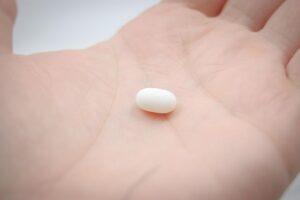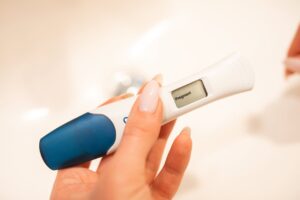
Is Having an Abortion Like Having Your Period?
You may have heard someone say that having an abortion is like having your period. But is that really true? While both may involve bleeding and cramping, what’s happening inside your body is actually very different. Let’s look at what’s natural, what’s not, and what’s really going on during each.
What’s Natural and What’s Not
Understanding what happens naturally versus medically is a good place to start. Not everything that’s “natural” is good, and not everything “unnatural” is bad—but it’s helpful for comparison.
Your period is a natural part of the female reproductive cycle.
An abortion is a medical process that intentionally ends a natural reproductive process.
Both may look similar on the surface, but their causes and purposes are completely different.
How Your Period Works
A natural menstrual cycle occurs roughly every 27–32 days. Hormone shifts cause your uterus to shed its lining, called the endometrium, which leaves your body as blood and tissue over about 4–7 days.
This process is your body’s natural way of resetting for a potential new cycle. If you would like to read more in depth about understanding your period, you can check out this blog.
If you’re using hormonal birth control (like an IUD or the pill), the monthly bleeding you experience is not a true period. Instead, it’s a result of artificial hormone changes that prevent ovulation. While it might look similar, it’s not the same as your body’s natural menstrual cycle.
How An Abortion Works
There are two main types of abortion: chemical (medical) and surgical.
- Chemical abortion (also known as the abortion pill) uses two medications to end a pregnancy. These drugs stop the pregnancy from growing and then cause the uterus to expel it.
- Surgical abortion involves a medical procedure to remove the pregnancy from the uterus.
In both cases, abortion interrupts a natural process your body has already started—supporting and nurturing a developing embryo or fetus. Instead of the body shedding only uterine lining as in a period, it also expels the embryo or fetus.
What’s Actually Happening in the Body?
During Your Period
Your uterus releases the endometrial lining it built up in preparation for a fertilized egg that never arrived. The tissue and blood pass through the vagina, often accompanied by mild cramping. This process is a normal, healthy part of the menstrual cycle and typically lasts 4–7 days.
During an Abortion
The uterus also sheds its lining, but in this case, it’s expelling both the lining and the embryo or fetus. An embryo is present through the first 8 weeks of pregnancy and may range in size from a poppy seed to about an inch long, depending on gestational age. During this stage, the basic structures for arms, legs, eyes, and facial features are already forming. At 9 weeks, it’s referred to as a fetus and continues to grow and develop.
Bleeding from an abortion can be much heavier than a period and may continue for several weeks.
Comparing Pain and Symptoms
Period Pain
Mild cramping, fatigue, and emotional changes are common during a period. Some women experience stronger pain or nausea, but these usually last only a few days.
Over-the-counter medications like ibuprofen or Midol are often enough to help manage discomfort.
Abortion Pain
The FDA-approved abortion medication, Mifeprex, lists cramping and abdominal pain as expected for all women. Bleeding is typically heavier than even a heavy period. Other possible symptoms that are known to affect up to a third of women include nausea, weakness, fever, chills, vomiting, diarrhea, and dizziness.
While some describe it as similar to a very bad period, abortion carries additional risks that periods do not. These risks include incomplete abortion, infection, hemorrhaging, or the need for emergency medical care, which can be fatal in some cases.
You should plan to have a follow up appointment with your healthcare provider to help lessen these risks.
So, Are They the Same?
On the surface, abortion and menstruation may seem alike. Both involve bleeding and cramping. But when you look closer, the differences are clear:
Your period:
- is a natural, recurring process
- typically mild to moderate pain
- only sheds uterine lining
An abortion:
- ends a natural bodily process
- involves stronger pain and heavier bleeding
- carries higher medical risks
- expels both uterine lining as well as an embryo or fetus
Know The Facts Before You Decide
Your body deserves to be cared for and understood. Before making any decision about pregnancy or abortion, it’s important to confirm whether you’re actually pregnant and how far along you may be.
An ultrasound can give you accurate, valuable information about your pregnancy and your health so you can make an informed choice.
Schedule a free, confidential appointment today.
FAQ: Abortion vs. Period
1. Is having an abortion like having a period?
While both may involve bleeding and cramping, abortion and a period are very different. A period is a natural process that sheds only the uterine lining, whereas an abortion ends a natural process (pregnancy) and expels both uterine lining and the embryo or fetus. Abortion also carries higher risks and stronger symptoms than a typical period.
2. What happens during a chemical abortion?
A chemical abortion uses two medications to terminate a pregnancy. The first stops the pregnancy from growing, and the second causes the uterus to expel the pregnancy. Bleeding may be heavier than a period and can last for several weeks, often accompanied by cramping, nausea, and other symptoms.
3. How is surgical abortion different from a period?
Surgical abortion involves a procedure to remove the pregnancy from the uterus. Unlike a period, which is a natural shedding of the uterine lining, surgical abortion actively interrupts a pregnancy and carries additional medical risks.
4. Can abortion pain be similar to period pain?
Some women report cramping during abortion that feels similar to a very heavy period. However, abortion can involve stronger pain, heavier bleeding, and additional symptoms such as nausea, dizziness, and fever. In some cases, complications like infection, hemorrhaging, or the need for emergency care can be life-threatening.
5. How long does bleeding last after an abortion?
Bleeding after an abortion can last a few days to several weeks, depending on the type of abortion and gestational age. This is typically heavier than menstrual bleeding and may include blood clots.
6. Why is it important to understand the difference between a period and an abortion?
Understanding the difference helps women make informed decisions about their reproductive health. Confirming pregnancy with an ultrasound provides crucial information about gestational age and helps assess medical risks before making any choices.
Recent Stories

Missed Period Pills: Understanding the Risks and Realities
Read Article
Is Having an Abortion Like Having Your Period?
Read Article
Salt Pregnancy Test: What It Is, How It Works, and If It’s Accurate
Read Article
Mifepristone: The First Part of the Abortion Pill
Read Article
